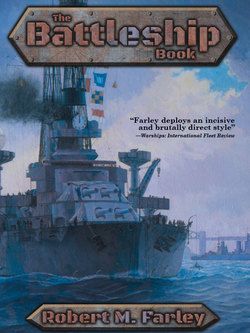Читать книгу The Battleship Book - Robert M. Farley - Страница 12
На сайте Литреса книга снята с продажи.
Turrets
ОглавлениеIn the pre-dreadnought era, naval architects faced few difficult choices with respect to arranging the main guns. Nearly every pre-dreadnought carried two twin turrets, one fore and one aft. Dreadnought, with five turrets, presented a much more complicated problem. Different potential turret arrangements each had their own benefits and drawbacks.
Wing turrets promised heavy end-on fire, but typically could only fire on one broadside. Some designs kept firing space open on either side, but this often caused blast damage and put strain on the hull. Wing turrets also created the need for more ammunition spaces, which increased weight and made the ship more vulnerable to explosion. Nevertheless, many early dreadnoughts and battlecruisers adopted wing turrets, especially in Germany, Japan, and the United Kingdom. Dreadnought herself sported a pair of wing turrets, giving her six gun end on fire, but only an eight gun broadside.
Other navies decided on superfiring turrets, which positioned one turret above and slightly behind another. The first dreadnoughts to carry superfiring turrets were the US South Carolina class, which carried eight 12” guns on four turrets, two forward and two aft. This gave them the same broadside as Dreadnought, on a smaller displacement. Several navies resisted the move to superfiring turrets because they were concerned that blast from the lower guns would throw off the aiming of the upper, but experience demonstrated that these concerns were groundless.
Still other navies adopted triple turrets, which were more complex than twin, but promised a savings in weight and space. The first ship to carry triple turrets was Dante Alighieri, which carried four non-superfiring triple turrets along the centerline. The first seven Russian dreadnoughts adopted the same arrangement. The Austrian Tegethoff class combined superfiring with triple turrets, giving it a twelve gun broadside and six gun end on fire. Some navies preferred to stick with less complex, quicker firing twin turrets. Others, including the Royal Navy and the Marine Nationale, opted for quadruple turrets.
Over time, certain practices faded; wing turrets fell out of favor by the beginning of World War I. Center turrets (not on either end) were big during the super-dreadnought era, but eventually faded as well. Most fast battleships used a three turret arrangement, with two superfiring turrets fore and one aft, but even this practice varied.
